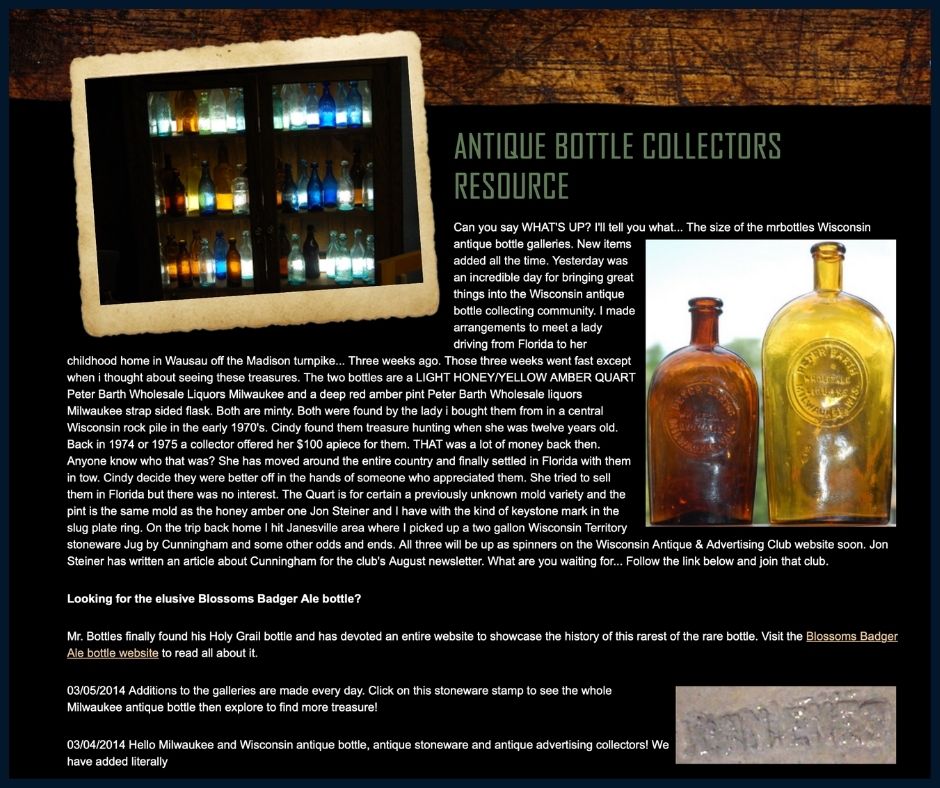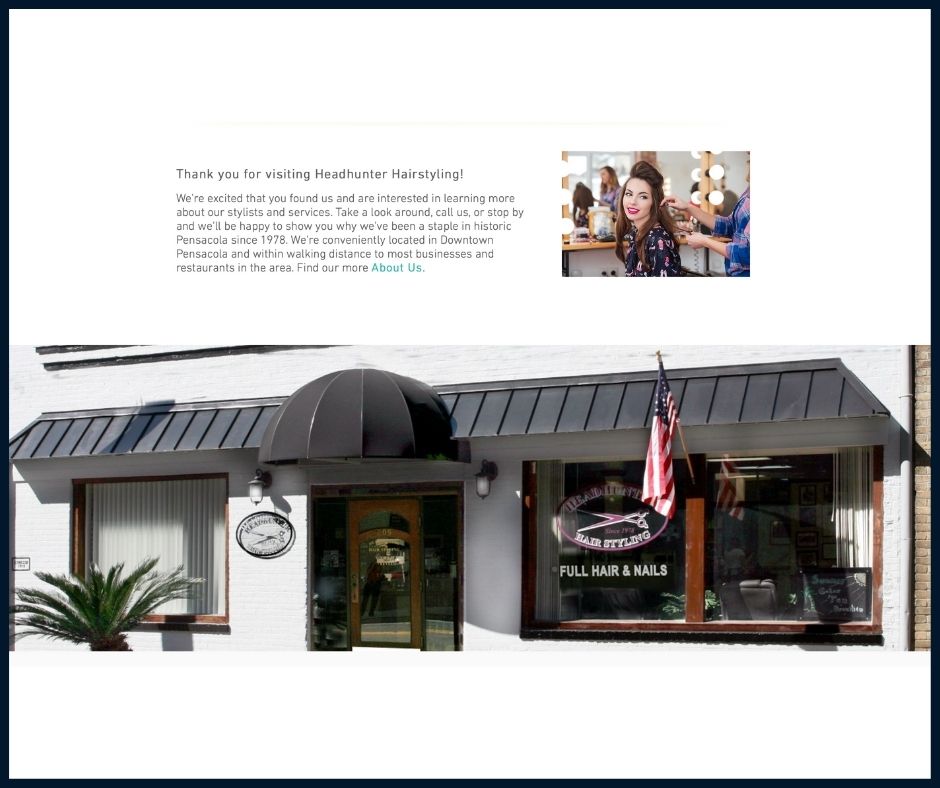Good marketing messaging isãer, good. Right?ô
It says what you want to sayãand hopefully what your audience wants to read.ô
And maybe thatãs good enough? Right?
 Well, perhaps itãs good enough for this renowned authorãÎ
Well, perhaps itãs good enough for this renowned authorãÎ
But if you land on her website and didnãt know that sheãs the very person who authored The Hunger Games, this homepage certainly isnãt going to help you figure that out (but you will learn that she likes to take pictures with ratsãÎhmmm).ô
 On the opposite end of the spectrum we have Mr. Bottles, an antique bottle shop with a whole lot to say about virtually everything (in white text on a black background, no less).
On the opposite end of the spectrum we have Mr. Bottles, an antique bottle shop with a whole lot to say about virtually everything (in white text on a black background, no less).
Sure, itãs an independently owned shop catering to a very specific audience. But what are the chances any of their customers are going to stick around long enough to read all this (and it goes on and on down the page)… Why do customers such a disservice?
 Finally, hereãs a perfectly middle-of-the-road example of ãgoodã web copy. After all, whatãs wrong with welcoming customers to your website?
Finally, hereãs a perfectly middle-of-the-road example of ãgoodã web copy. After all, whatãs wrong with welcoming customers to your website?
Everything.
By the time most readers have gotten through that first paragraph without learning anything useful about this shopãs services, theyãre very likely to move on to a place that caters their needs more effectively.
We can do better.
ãGood enoughã isnãt all that good.ô
And in a sea of content, marketing messaging today must be a cut above the rest in order to stand out and do its job.ô
OK, Fine. So What is Better Marketing Messaging?ô
Better marketing messaging is about getting the right message to the right audience, and compelling them to act on it. Itãs a bold splash of colour in that grey sea. With better messaging, you can tell that a piece of content was created both strategically and passionately, with a little spark of joy or impulse, by a real human person who has a photo of their kid and their cat pinned to their bulletin board.ô
Better messaging knows its audience, too: it doesnãt mention the cat or the kid without knowing that its audience might kinda like details like that.ô
And better messaging is empathetic. It knows and understands its audience, and what their particular challenges and needs are. It serves them, in the right places, at the right times.ô
Better marketing messaging, lovelies, results in better marketing content and more successful outcomes. Hereãs how it works.ô
Setting Better Content Objectivesãor, Rather, Defining Exactly What You Need Your Audience to Do
Marketers usually know pretty well what their goal is. They live by KPIs and measure their successes by them. But is there, for you, a gap between those high level goals, and your ability to create content that gets you closer to meeting them?ô
For a lot of marketers, that gap is huge.ô
 So huge that content creators are often faced with creatorsã block, despite knowing their businesses inside and out. This often results in a frantic spewing of random content just to fill the void.
So huge that content creators are often faced with creatorsã block, despite knowing their businesses inside and out. This often results in a frantic spewing of random content just to fill the void.
Say ãhell, yeahã if thatãs ever happened to you. Go on.ô
As a content agency owner Iãve despaired over this gap. And then filled it in with a simple and quite beautiful (if I may say) little fix: adding a couple of extra vowels (AA) to the olã OKRs which speak directly to what you most want and need your audience to do (and how your marketing messaging can help to make them act).ô
Want better messaging? Start with better personas.ô
Download our 20 best questions to create your best customer persona.ô
[activecampaign form=4 css=1]
Introducing Audience Actions (AA): An Audience-Focused Spin on OKRs
OKRs might be familiar to you. Objectives and Key Results represent a well-used tool for companies like Google and Amazon (and beyond) in keeping teams aligned to get things done.ô
In essence: a business department or team sets a business objective. Letãs say itãs the sales team, frustrated with talking to leads who just donãt have the budget for their services. So their objective is: ãGet More of the Right Customers.ãô
See? The objective doesnãt have to be clear or smart or much of anything other than really, truly something the department or team wants to achieve. Herein lies the beauty of OKRs. You donãt have to get all picky or snooty about whether itãs SMART or not (at least not yet). You just say what you want to do.ô
Then in the Key Results section, you can get more picky. Like: what do you need to happen to show youãre making progress toward attracting the right customers? Whatãs everything you need to achieve in order to be able to say you are now attracting the right customers?ô
For our fictional sales team, Key Results might be:ô
- Less time spent on email or calls with dead-end leads
- Higher percentage of sales
- Maybe a higher percentage of ãgoodã leads ã which means also:ô
- A rating system for leads – which might mean also:ô
- A way to quickly and effectively say no to the wrong leads
This list becomes your list of Key Results, folks. And the best part is that identifying this list reveals to everyone on your team what actually needs to be accomplished in order to meet that big olã objective. Itãs eye-opening, to say the least.ô
In bigger business operations, you assign people or teams to deliver on those results, and bingo, youãve accomplished that objective and can head onto the next.
Where Big Objectives Donãt Always Work for Brand Messaging
So now we get to the gap between those bigger picture business objectives and your content or marketing team.ô
How exactly does a content team set out to Get More of the Right Customers?ô
What weãve learned as a content agency is that you need to set out to achieve smaller objectives.ô
And you can do this by asking the question: how can content help to achieve one of the bigger key results, and/or contribute to the bigger objective?ô
We call this a Content Objective. How can contentãwhether blog posts, Instagram Reels, TikTok videos, or long-form whitepapersãhelp you achieve your business objectives? What could content marketing and the right messaging help you achieve?ô
In our fictional example here, we might say content can help to generate more qualified leads, and that it can (if done right) efficiently enable people who find the business to figure out if theyãre a fit.ô
Good content allows your audience to self-qualify, because they can quickly tellãthanks to what you say and how you show up in your contentãif youãre their people.ô
For the purposes of content marketing, weãve added another spin on it ã identifying first the actual thing that content can help your business to accomplish, the key results that you can measure along the way to achieving it, and also ã what you actually need your audience to do in order to accomplish those key results.ô
Identifying Targeted Audience Actions WILL Lead to Better Marketing Messagingô
We suggest that you begin your messaging work with one particular audience in mind. If you have existing personas, fantastic! Choose one that youãd like to develop messaging for.ô
If you donãt yet have personas fleshed out, we suggest starting with either an audience group or particular clients whom you love and want more of; or a new particular audience that youãd like to use content marketing to reach.ô

With an audience group in mind, interrogate what they want from your business and your content, and start to consider the world from their perspective. To do so, start with these basic steps:ô
1. Dig into Your Data
Find out what you can from your own data: Google Analytics, social media insights and reporting, and email marketing. Whoãs reading your stuff? Whoãs visiting and leaving right away? Whoãs clicking or opening? Exactly what are they consuming and liking and commenting on most AND least? Make a list. Put it in a spreadsheet. And psst: If you donãt already know what your targeted Audience Actions are, looking at dataãand identifying what you get most excited about seeingãis your clue!ô
2. Talk to Your Teams
What results (or lack thereof) is your sales team most focused on? Your marketing team? Who among your online audience do they feel is most, and least important to your business bottom line? What audience actions are they most jazzed about?ô
3. Look at Your Competition (And At Who They’re Talking To)
Yep, get lurking. Dig into the social feeds of your best and fiercest competitors to find out who theyãre talking to and how theyãre serving them with content. Make note of the messaging that underlies their content: what are they actually saying to their followers and customers, beneath the words? Then note what you love, and what you could do with your resources, and consider ãstealing like an artist,ã as Austin Kleon says. Or like a very good marketer.ô
4. Ask Your Audience!
Saved the best for the last. Yes. You must know your audience. To do this, start by listening and watching and closely observing, but you can also cut to the chase by simply asking them. Most customers donãt mind offering their opinions if they know why youãre asking, and if they feel like youãre honoring and appreciating their generosity. At our agency, we sometimes tack on a couple of questions to the end of a Zoom call, or send out a quick survey with an explanation of how their answers will help us. Be patient, and express your generosity. It works.ô
What to Ask to Ensure It Translates to Action
At Forge & Spark weãve developed and shared our own list of tried-and-true persona questions (scroll down to download them!) which roughly divide into questions about your audienceãs motivations, or ãJobs to be doneã, their demographics, a few deeper dive questions depending on whether theyãre on the B2C or B2B side, and some questions to disqualify customers, too. Very important to remember who you DONãT want, too, and to clarify whoãs who.ô
When you do set up a call or survey with your audience, save some time by starting with these tried-and-true questions to better understand what they most need and want from you.ô
Armed with answers, youãll be able to knowledgeably start sketching out informed, and human personas for your marketingãand most importantly, youãll have a person in mind when you develop messaging that drives results.ô
Are Personas Really All That When It Comes to Messaging?ô
Yes. Based on our collective experience as an agency with hundreds of clients, we strongly feel that developing personas is the single best way to boost the ROI of your content.ô
Most marketers are, after all, using content for marketing with the intention of generating sales, leads or some kind of conversion, or to create some kind of impact. Think back to your own goals. Yes?ô
Now, you can certainly yield some marketing results through ads and accidents.ô
But if youãre in a business that needs to educate your customer, and/or build trust, you simply must have an understanding of who youãre talking to, and what they need and want from you.ô
Only then can you create messaging that makes a connectionãand that serves you both.ô
I wish you the best with your marketing messaging and with your relationships with your well-understood audience!
Please reach out if you need any support with your content marketing or audience growth strategies, orãhey!ãcheck out and join in on our full course on Better Messaging (and Better Results).ô
ô
Want better messaging? Start with better personas.ô
Download our 20 best questions to create your best customer persona.ô
[activecampaign form=4 css=1]














